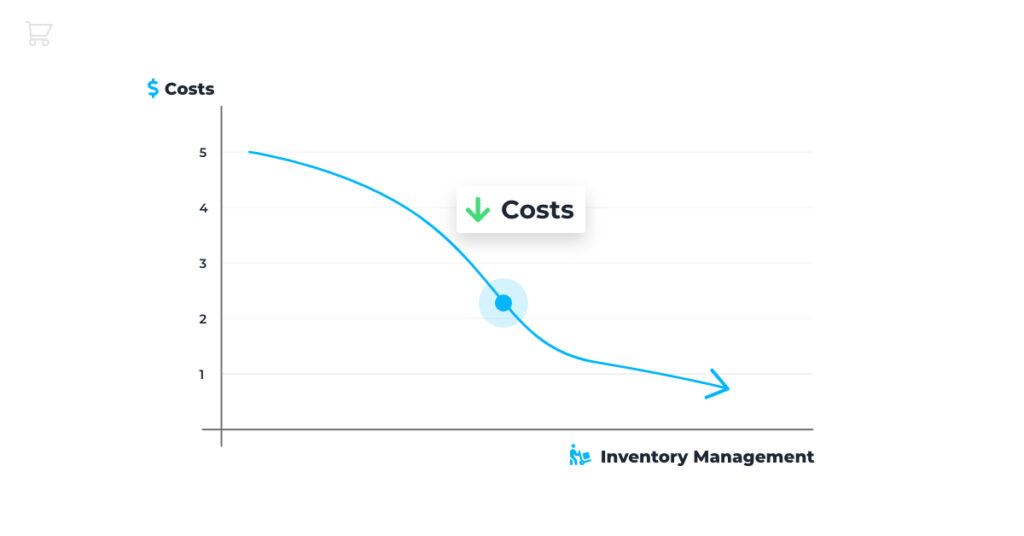Inventory management is one of the most important activities to boost your profit margins and customer satisfaction. In short, keeping the right amount of inventory on hand is key.
The effects are significant: improving your inventory management by 15% can add over 30% to your bottom line.
Here are a few more reasons why inventory management is so important, and how you can do it better.
- How Inventory Management Can Reduce Your Costs
- How Inventory Management Improves Customer Satisfaction
- How Inventory Management Frees Up Cash
- How to Manage Your Inventory
How Inventory Management Can Reduce Your Costs
Small businesses often try to place large orders with their suppliers to qualify for bulk discounts. With big orders you can negotiate better shipping rates or payment terms. On the surface, it sounds like an easy way to save on costs.

But here’s what many forget: the cost of purchasing your stock isn’t the only cost of inventory. Here’s where inventory management comes in. The more inventory you hold, the more space you’ll require to store it, in a warehouse or in your retail store. You’ll need to insure the inventory against theft or damage. If you’ve got multiple stores, reallocating your stock from store to store also costs money. And let’s say your inventory isn’t selling well. In this case you’ll have to discount it, or maybe even write it off entirely, e.g. perishable items that spoil, or out-of-season fashion.
If you’re holding more inventory than you actually need, these costs can add up and overpower those discounts that attracted you to the bulk purchase in the first place. So try your best to make sure you’re only buying the inventory you need and can effectively manage.
How Inventory Management Improves Customer Satisfaction
On the other hand, it’s just as important to ensure that you’re buying enough inventory to meet customer demand. Put yourself in the shoes of your customer. Imagine walking into a store expecting to find a specific item. How do you feel if you find out that it’s our of stock? You might be so disappointed that you may never return to their store.
So you as a seller just lost not only that sale, but the customer altogether.

More than 80% of shoppers want to check nearby product availability online before they visit a store, and nothing’s more upsetting than travelling there only to discover that the item isn’t actually in stock. The same applies to online stores: customers place online orders expecting the items to be in stock and ready to be shipped (unless you tell them otherwise). Effective inventory management helps to avoid these situations, notifying you in advance when you need more stock.
Retailers with a multi-channel sales strategy are now choosing to fulfil online sales from their in-store stock, effectively combining all stores’ inventory into a single virtual warehouse. You can certainly make better use of your floor stock, but it will only work if you’ve got a clear picture of how much you’re holding and where.
How Inventory Management Frees Up Cash
In accounting terms, the inventory that you’re holding is an asset, similar to your computer or car. Even though it has a dollar value, you can’t use it to pay your bills or buy that new POS system you’ve been eyeing. You have to convert it into cash (by selling it) first.
If you buy smaller quantities of inventory more often, you end up keeping more cash on hand instead of tying it up in stock. This is especially important for small businesses and startups, which are more vulnerable to fluctuating cash flow. If you track your inventory well and have a clear understanding of what’s not selling, you can then discount it early, recover that cash sooner and (hopefully!) avoid a write-off. It’s all about being proactive, not reactive.
How to Manage Your Inventory
“20% of small businesses fail in their first year, 30% of small business fail in their second year, and 50% of small businesses fail after five years in business.” Considering these stats, you really shouldn’t ignore the importance of an inventory management strategy. But where do you start?
First, you need information — where is your stock, when, and who is buying it. Understanding your sales trends will help you avoid holding too much inventory and the costs that come with it. These insights will also prevent missing out on a sale you should’ve been able to complete. Some seasonal products are popular at certain times of the year or month, so it’s important to have a system that lets you track your inventory movement and forecast demand.
Then you’ll want to speed up your reaction time – how quickly can you act on that information?

Here’s a scenario: let’s say you’re counting stock and placing orders manually. That process takes you two weeks. After that, it takes another six weeks for your supplier to deliver. This means that you’ll need to buy enough inventory to last you eight weeks at a time.
You don’t need to though. If you’ve got an all-in-one retail system that combines your inventory management with your sales and ordering systems, you’ll be able to monitor stock levels in real time and place orders as soon as you get low. Here’s the real impact: cutting your eight-week inventory cycle down to six weeks means you’ll have 25% less cash locked up.
You also want your inventory data to be accessible everywhere, backed up and secure. You need to always know the value of your stock on hand, no matter where you are or what’s going on.
All of that is possible with the right inventory management approach. And all of the inventory activities are much simpler and more frictionless with inventory management software. Check out Maropost Commerce Cloud that allows you do just that – save time and money, remove stress, and focus on your business.
Need to chat about your mobile marketing strategy?
More than 10,000 marketers use Maropost to engage with their prospects and customers through emails, SMS, social media and more. We’re here to help you grow your business!
Chat Now

